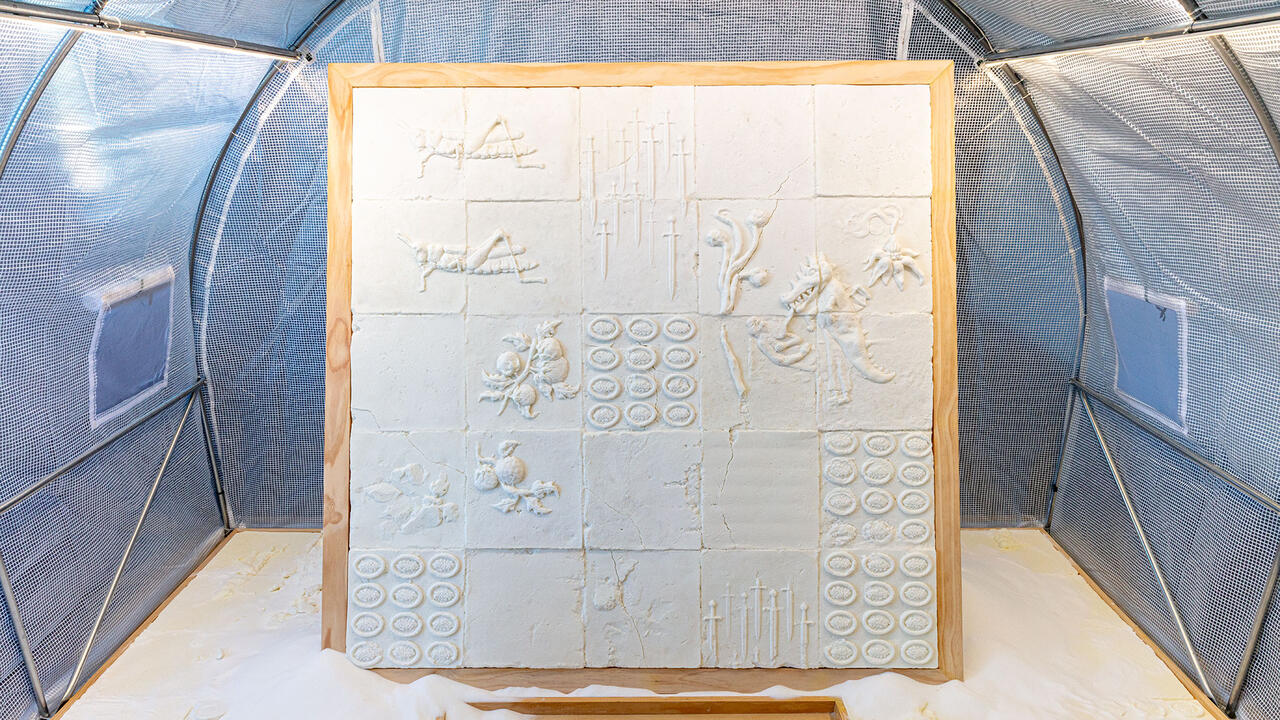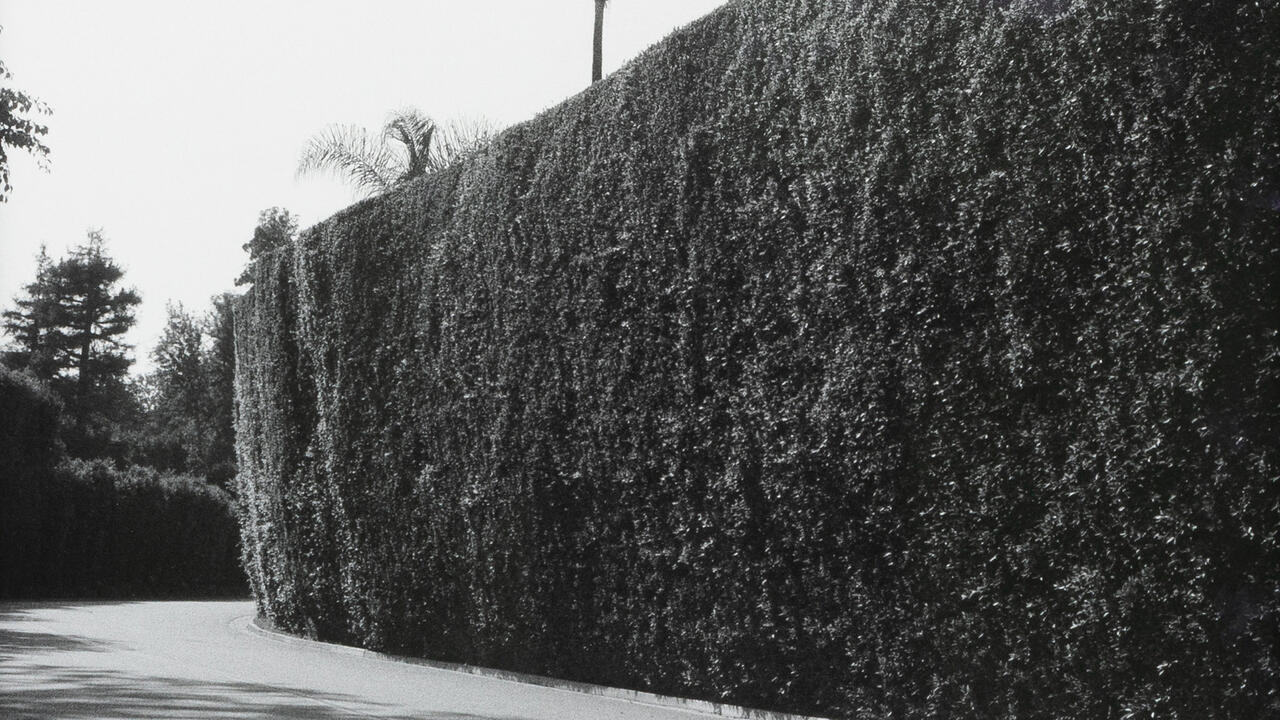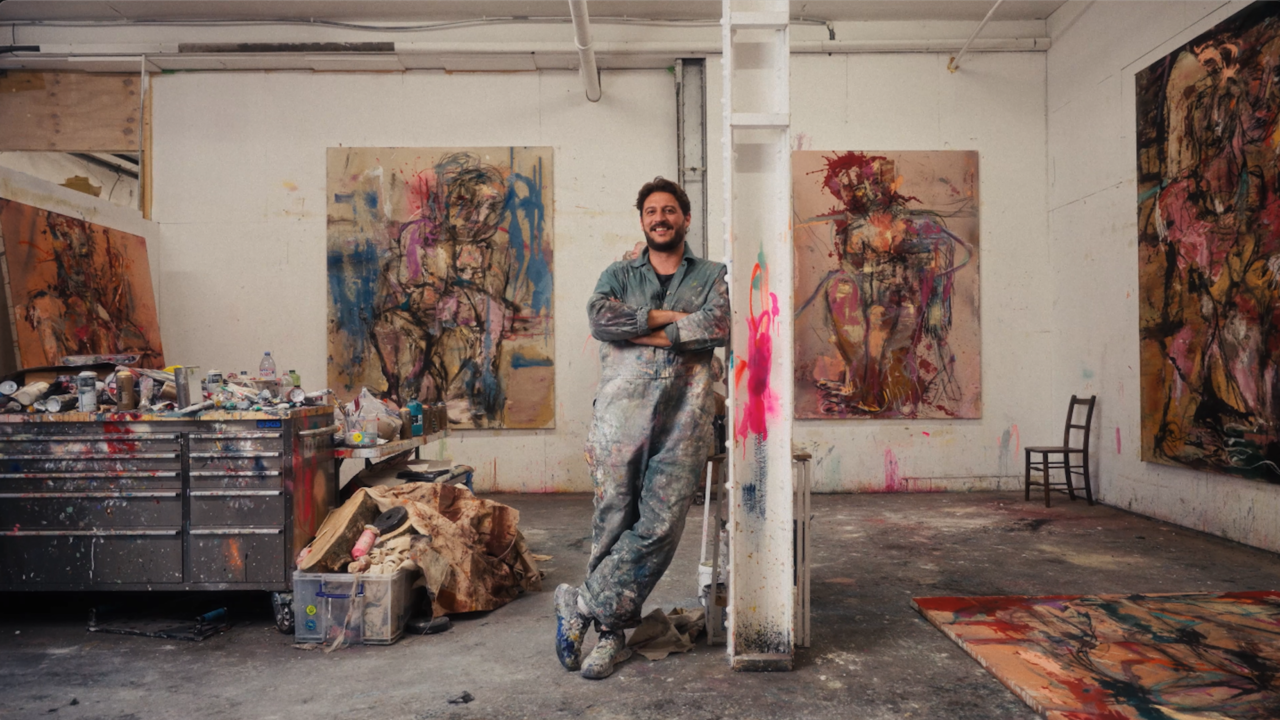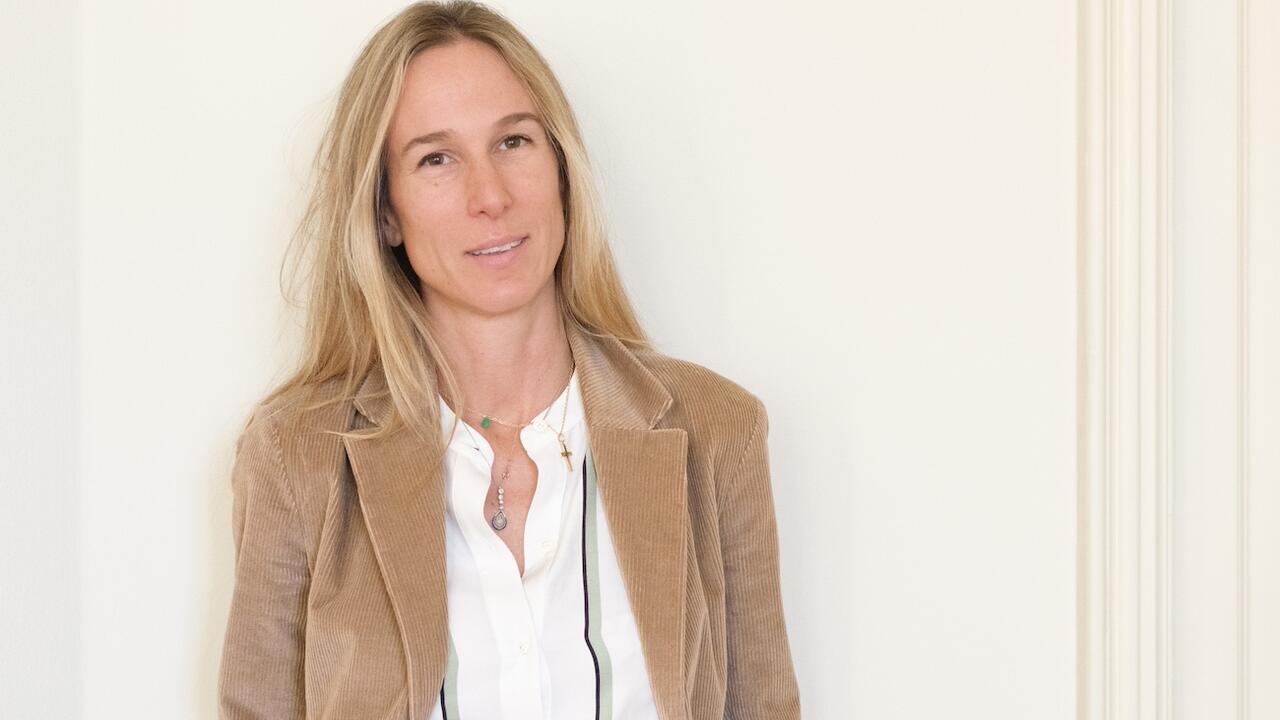Don't Look Now
Reflections on the situation in New York and interviews with four young Italian artists
Reflections on the situation in New York and interviews with four young Italian artists
The emerging feminist artists of the 90s have adopted a very different set of priorities and strategies than those of their immediate predecessors.
Dan Cameron examines the situation in New York as reflected by two recent shows, while Anthony Iannacci interviews four young Italian artists.
For quite some time now, a revealing symptom of our intellectual carelessness has been the general tendency to consider the cultural issues introduced by feminism as a kind of closed set -- whose presence, theoretically speaking, has already been sufficiently established for everyone involved to feel that she or he has a well-established relationship to the issues at hand. That feminism must exist not only as a multivalent but also an organic force, changing shape at the same rate that society re-molds itself to accommodate male priorities, might have been a self-evident principle to the women's movement's foremothers, but it does not seem to have been quite so clear to either their adherents or their detractors. As an unfortunate result, many of those initially sympathetic to feminism's promise fell off the bandwagon through disillusionment at some point during the 80s, or else became so specialised in their concerns that their real impact on a broader cultural scope was practically nil.
As the world changes, however, so do the ways in which we permit others to assume control over our lives. In a repressive, neo-puritan climate like the present, the possibility of not having a feminist critique on hand to deal with the day-to-day tyranny of patriarchal society seems as unimaginable as not having blacks or gays available to offer a vision that goes beyond what white heterosexuals might have come up with, were they left to their own devices. Even when it is in accord with the more obvious priorities of the state (which is rarely), feminism still offers an alternative to the present hierarchy of control, because it most likely took a very different course to arrive at the same result. And it can almost be taken for granted that even if some basic principles of feminism became the presiding wisdom in certain areas of society, the result would be an enrichment of the political process, if only due to feminism's almost overwhelming capacity for self-critique. With the emergence of an important generation of photographically-based artists, mostly women, in the early 80s, feminist critique established itself as one of the fundamental impulses behind the stylistic developments of that tumultuous decade. Particularly in New York, the overlapping range of issues found in the images of Sarah Charlesworth, Cindy Sherman, Sherrie Levine, Louise Lawler and Laurie Simmons, as well as the work of more linguistically-oriented artists like Jenny Holzer and Barbara Kruger, held out a critique whose promise was steeped in a highly rigorous world-view, although one not entirely lacking in humour. In part as a reaction to the preponderance of highly-charged expressionist painting and sculpture being promoted at the time, much of this art conveys an austerity of materials and gesture that often appears censorial in retrospect. Specifically casting a sceptical eye toward the art-historical prototype of the uniquely creative (male) genius whose very touch bestows artistic greatness on the most mundane subjects and materials, one of the specific accomplishments of this group of artists was its successful undermining of some of the cultural standards which the narcissistic male ego holds most dear, thus leading the perspicacious viewer to consider the many other ways in which such excesses might be brought to bear in real life.
Although it is still much too early to speak with any real authority, it would appear that the emerging feminist artists of the 90s have adopted a very different set of priorities and strategies than those of their immediate predecessors. Gone are the carefully-phrased ironies and the dry, sardonic edge of much of the conceptually-aligned work of the 80s. Instead, a new generation has emerged to lay claim to a vast territory of materials and subjects, in the process altering once more the way in which feminist ideas will come to be defined in relation to the so-called cultural mainstream. As if to jettison the streamlined look of neo-geo, the use of found materials in now being powered by a predilection for flimsiness or apparently haphazard design, with seemingly luxurious materials (especially fabrics), bright colours and rampant figuration appearing almost as an attempt to crowd out our recollection of a time when all art had to be black, white or red.
Until quite recently, it was nearly impossible to formulate such ideas in terms of general observations about the actual art being produced today. As of last fall, however, a pair of New York exhibitions suddenly changed the way in which such developments were perceived by the gallery-going public, and may in fact be remembered as marking the first significant group exhibitions of the still-nascent decade. Organised independently of one another, these simultaneous projects - Plastic Fantastic Lover (object a) at Blum Helman Warehouse, and Painting/Culture at fiction/nonfiction - nevertheless served as near-perfect complements. The first exhibition, put together by critic Catherine Liu, was an ambitious, sleekly international survey of new sculpture, accompanied by a handsome, if low budget, catalogue, while the latter consisted basically of an informal grouping of five local painters brought together by gallery director Jose Freire after an idea by Deborah Kass (one of the artists in the show), accompanied by a press release. Although Painting/Culture was also marked by a star-studded panel discussion of feminism in the 90s that filled the Great Hall at Cooper Union, both events were notable for their conspicuous dissociation with familiar streams of p.c., or politically correct, feminist thought. The very separate ways in which they accomplished this act of distancing provides the best opportunity to examine each of the shows separately, and then discuss their mutual implications.
Bringing together the work of twenty-one artists from several different countries is never an easy job, even when the odds are stacked heavily (about 2 to 1) in favour of Americans. But Catherine Liu had a specific look in mind for Plastic Fantastic Lover, that of 'an eclectic sampling of different strategies of artistic production in the absence of the Master,' as she articulates in the imaginative catalogue text. Although she does not come out and say so, Liu appears to have chosen sculpture as a medium (except in the case of Mary Weatherford, who is the only artist in both shows, and whose work also looks out of place in both) because the conjured spirit of constructivism allows her installation to concern itself implicitly with somewhat traditional principles of form-building, as opposed to form-borrowing or tearing apart. Noticeable in its absence is the work of Cady Noland, who is probably the most celebrated member of the 'scatter' generation of artists to emerge from the ideological rubble created by Jeff Koons. But then, Noland's work is also too conspicuously anti-beautiful to be included in such a selection, where it is abundantly clear that a link is sought between feminist and feminine modes of addressing the world.
Much more appropriate to Liu's thesis is Rona Pondick's hanging mobile incorporating dozens of novelty chattering-teeth embedded in what looks like bubble gum. The surprising physicality of Pondick's materials belies both the humour and the sense of macabre in her work, which has always conveyed a preference for embarrassingly personal materials used in excess. Polly Apfelbaum's floor-piece of pom-pom material, and Beverly Semmes' wall-construction from a group of identical crushed-velvet nightgowns whose trains meet and become one as they fall to the floor, giving an impression of personal sentiment being adapted to art's transformation of the everyday into the sublime. Even the more conceptually-based work in this exhibition has a light-hearted feel to it, as demonstrated by Sylvie Fleury's object lesson in decadence: an accumulation of empty shopping-bags from the best boutiques and department stores, looking just as if they'd been tossed aside after a long day's excursion into consumer paradise. If the most formally satisfying work in the show was Jessica Stockholder's jerry-rigged pile of construction materials that seem to have been abandoned halfway through the job, the choice for crowd-pleaser remained a toss-up between Angela Bulloch's disarmingly stupid row of programmed blinking lights, which seem to be parodying artificial intelligence, and Andrea Zittel's breeding unit for guinea hens, which kept detailed records of eggs laid during the three-week exhibition period.
If Plastic Fantastic Lover tended toward the poised, careful and even demure aspects of its subject, Painting/Culture was a jarring and unapologetically sloppy assault on the senses. Stemming from the premise that a number of women artists with theoretical roots have moved into the field of figurative painting with a vengeance, the knot of the exhibition is provided by the issue of representation, specifically as it pertains to hand-painted renditions of mechanically-reproduced imagery. For example, Kathe Burkhardt's tabloid paintings of Elizabeth Taylor made more sense in this context than they usually do, just as Jane Hammond's schematic representations of cultural exotica hint at a subversive meaning that doesn't usually seem to be present in the work. But the emotion that played best in Painting/Culture was good old-fashioned anger, such as that dished out by Kass' mocking send-up of artistic misogyny entitled Portrait of the Artist as a Young Man. Just as Kass conveys her idea of poetic justice by painting a nude, spread-eagled man in a less than flattering light (a David Salle with reverse twist), Sue Williams reaches back into a collective memory of child-abuse, and produces the terrified, tear-soaked face of a little girl gripping her doll as she stares at the genitals of a middle-aged man whose pimply buttocks we have to look through to see her.
The nastiness expressed by several of the paintings in Painting/Culture bears our particular attention because it is so explicitly worn on the artists' shirt-sleeves. For this reason alone, it signals an abrupt departure from the somewhat more detached feminist critiques of the 80s, re-casting the issues of the women's movement in terms of that which you cannot bear to look at combined with that from which you cannot avert your eyes. Certainly from the point of view of a modified theory of hysteria, the critical divide between Sylvie Fleury's shopping-bags and Sue Williams' child-molestation picture is not as great as current taste might suggest: one need only place an imaginary twenty-five year gap between the two artworks to see the 'subject' of both as being the same person. But the most satisfying after-effect connected with the pleasures of the works in Painting/Culture is the sense one gets that, culturally speaking, we seem to have evolved to the point where the most interesting younger women artists are no longer having to invent their own media or stylistic languages in order to make radical statements, but are doing so within formal parameters - in this case, Pop-derived expressionist painting - that had heretofore been practically the exclusive domain of men. And since painting has been one of the most disparaged of art forms in recent years, it is illuminating to consider that its future growth may now come to depend on the contributions provided by those artists who are most effectively exploiting painting's unique capacity for creating indelible images in order to ridicule gender-based priorities out of existence.
Viewed in conjunction with the developments in sculpture highlighted by Plastic Fantastic Lover, such reflections might in fact lead one to reconsider the efficacy of one of the more oft-repeated motifs of present-day culture: the death of the avant-garde. Only a simple comparison between the artistic breakthroughs of the last decade versus those of thirty years ago is necessary to see that the automatic bridging of art and scientific progress - one of the keystones to belief in the avant-garde - is an untenable position today. But relying on only one historical model of the avant-garde is not the same as supporting radical change in art's self-definition, which can take place on several different fronts simultaneously. What is important about exhibitions like these is that they uphold the premise that artists working today seem infinitely more interested in renovating culture rather than innovating it, making it essential to understand the forms in which such re-structurings will take place. If a great deal of this art seems conspicuously out of step with accepted streams of both feminist and artistic thought, that is because one of these artists' most pressing problems is the merging of social and political concerns with purely aesthetic ones. Although this is a very tall order and not an entirely original one, it at least permits us to observe one aspect in which these artists are conducting themselves in a manner that befits an avant-garde: by changing the rules first, and then waiting for the rest of the world to catch up with them.
Anthony Iannacci spoke with Elena Berriolo, Daniela De Lorenzo, Liliana Moro and Paola Pezzi, four Italian women artists, about their work, and how, if at all, they have been affected by feminism or feminist issues.
Anthony Iannacci: It seems obvious from your work that you are a woman.
Elena Berriolo: I feel the enormous weight of a history in which there are no female models, therefore when I as a woman attempt to make art I must in some way forget my femininity and appropriate a humanitarian dimension which has been exclusively masculine. Therefore as an artist I do not feel like a woman, but like a man. A man in search of his humanitarian dimension. My goal is to be a man but the fact that I am a woman obviously escapes and becomes evident. But I try to control it as much as possible. I try to keep it within limits.
So you want to be a man instead of a feminist.
Not a man in the masculine sense, but a man in the cultural sense. As an artist it is not important for me to occupy a distinctly female position, but from a personal point of view it is very important.
Do you feel a need to fight against the lack of space for woman here in Italy?
Well I am not so sure that there is such a lack of space and think that many of the problems women face are our fault, my fault as well. Because women, and this is not my idea but something that has been elaborated by others, are conditioned to wait. Waiting is part of our collective feminine culture. We wait for something to fall out of the sky. We wait for a boyfriend, Mr Right, a child - and the dimension of waiting defines Italian woman because of our intense relationship to motherhood. Once a woman has discovered her will to be aggressive, her will to stop waiting, it all becomes much easier. And it is exactly this aggressiveness that women here are still without.
Can you be aggressive with your work, can you eliminate this dimension of waiting from your work?
I try to make an aggressive work, and in this way appropriate a masculine condition within humanity. All of this is a challenge because this aggressiveness does not belong to me but to the culture of men.
So in your work when you electrically shock people or shock them with strong images your intention is to be aggressive and not wait, but what is left at the end of this aggression?
Well I feel as if I have communicated.
Communicated of acquired power?
Well in that moment, when someone is actually shocked by an image or by an electrical current, I am sure that in someway a message has been received. My problem is wallpaper, creating something that goes unnoticed - I need to avoid this at all costs. I need to pronounce myself and not me with someone else or part of some collective context that calls to mind notions of family.
And this work with the woman on the swing - what does it say?
I wanted to use a female figure with soft weak forms: She is almost without muscle and she is on a swing which moves by inertia and not by her physical force. What is in view is her femininity, her sex. It springs out and hits you in the face. I see the entire thing as an act of passive violence, which basically happens in continuation.
Why the curtain, does it have a relationship to the domestic environment?
The curtain firstly is a way of avoiding making a painting and secondly it creates a desire to look behind it, which is like looking up a women's skirt.
Anthony Iannacci: Are you afraid that your monochromatic works with embroidery might be seen as being weak, or go easily unnoticed?
Daniela De Lorenzo: This has happened and I was told that I was appropriating a certain type of women's work, but that was not my intention. I was interested in the idea of sewing on canvas which is quite different from drawing or painting. Sewing, even the word itself, carries with it notions of binding and rendering things stable and this is what I was after and not a comment on women's work. These works represent fixed points within architecture, points which are very important for their reading. They are always referring to a line which, in this case, is sewn on the canvas. These forms I construct with embroidery come from certain architectural plans which are often Byzantine or Arabic and are based on the rotation of squares or quadrilaterals.
Why architecture?
I have always looked at architecture. I adopt it for my use, perhaps even as decoration and it has provided me with an endless assortment of forms.
You appropriate architecture and often make it smaller, as was the case with your works with brass. Is this more feminine than appropriating architecture in order to actually build?
No - I am using these elements for distinctly my own purposes which have nothing to do with building.
Your new works are notably softer than those of a few years ago and earlier you said that these works derive from architectural forms mixed with organic forms.
Yes, now I am using cloth, felt, wood, cardboard and have abandoned iron and stone. And in the more recent works I am precisely looking at that which is organic even within architecture, which through its history has often looked towards nature. But I am trying to specify something precise with these forms. I am not adopting them only for their formal function but considering firstly their origin or original function.
What then are you trying to specify with the work?
The origin of the forms I appropriate has become very important. I have designed these forms, but they come out of research I did on other objects designed to contain water. I was looking at fountains, basins, cups, etc. This work, made out of turned wood, called to mind water containers, and all of this is tied to the way these forms were made. They are turned and the remaining concentric circles remind me of the movement of water. By looking at what is already around and by reusing these forms I am able to re-evaluate certain aspects of art.
Your intentions then are clearly not critical.
No, I am trying to recuperate something I feel has been lost. A certain type of thought that ties us to nature, for example, that reunites a thought of nature and art to the sublime. And this is also tied to my use of architecture, when I used embroidery to create a series of rotating squares reminiscent of Byzantine architecture, I was thinking not only of that architecture but of a lost relationship to our surroundings in their most simple context.
Anthony Iannacci: With this work it seems obvious that you are commenting on a certain condition in which some women find themselves.
Liliana Moro: With this work I was thinking about an idea of pleasure, the pleasure of the gaze. You enter a peep-show, pay and see nude women like you go to a museum, pay and see a nice painting. As far as the women are concerned, I was not trying to comment on their particular situation but concentrate on the spectator's gaze. The peep-show is a particular place. Everything is seen through a two-way mirror, there is no direct contact with these women, you can not touch them and above all they do not see you. The entire experience for the spectator is very intimate. You are closed in a booth where you can stay as long as you like, you drop money into the slot, a curtain goes up and you can look. I saw these women and simply wanted to underline the reality of this place.
So you took these two things that are looked at - women and paintings, and placed them together.
The one thing that I did not want to do was to create another object - because in this context these women are already objectified. I projected a series of Italian paintings onto their bodies and called it Souvenir d'Italie. Strangely the images I projected somehow dressed the women and some of the clients were complaining.
Do you think that the work you are doing with dolls is feminist or that it is a distinctly feminine work?
I am often asked similar questions. I think that a man can arrive at using these images just as easily as I did. Imagine that a man were to project images onto the bodies of women in a peep-show. He would obviously bring to the work the different context of his feelings and desires, but this is distant from the actual materials. This is the case even when considering the dolls that I use. I think that we need to go beyond the physical element that might be considered masculine or feminine to arrive at the sensibility of the artist.
And your appropriation of the infantile and the childish.
What I like about these infantile elements is their simplicity. Formally they are often very clean and capable of communicating without going through other filters. If you provide a child with simple images he will then let his imagination work. We are surrounded by over-worked, over-charged images without memory, but the simple images that I try to use tend to function as empty containers for a very personal memory and establish a direct relationship between the work and the viewer. I do not worry about what the images might provide, instead think about what the viewer might elaborate.
So you use these childish images because they are simple and clean and provide occasions to use our imaginations.
I took images from children's colouring books and provided only the outlines of the forms which I then painted black and presented in rat-traps, in cages. A farmer, for example, was just an outline - you could provide the details yourself.
You use many containers. Like the women at the peep-show, there are the works where foam rubber is closed within a grid-like structure, the cages for the images and the sound boxes. You have even transformed rooms into containers.
Something that contains or holds seems to represent my way of seeing, a box can hold or it can simply be a skin. I start from my body, from my way of moving and looking, which is either on the inside or outside of some other container. I always try to arrive at an image that is compact, that does not get dispersed. When, for example, I filled drawers with thermometers I was trying to arrive at a contained work that would give you its sense in one shot only without any dispersion. You see it within its physical closure. Boxes and containers can do this.
Some might say that these containers, draws and boxes are symbols for female sexual organs. How did you feel about putting that farmer into a cage?
When I lined the room with foam rubber, much was said along these lines. It makes me laugh a bit. My intentions were not to simply create an enormous vagina. The foam rubber room was called Gran Paradiso (Great Paradise) because it provided a very intimate experience. The information was there.
Anthony Iannacci: When I look at your work what seems most important is this continued gesture of putting two similar objects together and wrapping them up.
Paola Pezzi: Perhaps this is because the work has a rhythm that is immediate, everyday and that follows me.
And this gesture of wrapping and packing - is it feminine?
I have no idea. It is mine and belongs to my everyday reality.
How did you start doing these works?
Well, in reality, it has no start. These works have been recycled from other previous works which I have cut up. These materials that I eventually wrap are pieces of old works that I continue to cut up and recycle.
Then you made a lot of works.
Yes, I am still using old works, but the strange thing is that they were very big. First I did these big works and then arrived at these very small ones by cutting and then destroying them only to then put them back together in a new form.
I once told you that these works seemed to belong to another culture.
I think a lot about the past and these works often resemble distant relics but even relics of our time. They have a worn appearance but they also are very contemporary because of their materials.
They look like old bricks or stones, what is contemporary about that?
They look like bricks or stones but they will always just be foam rubber. At first they assimilate the appearance of some archeological find, but then they turn that assimilation upside down because in the long run they are simply my archeology. These are my contemporary daily products.
This aspect of having an appearance that is actually very different from their reality is fascinating but one also feels tricked or fouled. Is it fun tricking people?
There is this heavy aspect of the work which I tie to memory and like some found stone the works carry with them an imagined history. On an intellectual level I think the work maintains this heaviness, this weight but as you get closer to the work, if you hold it in your hand, for example, it starts to confuse these ideas and it is their physical lightness that initiates this strange confusion.
Are the works fake then?
No, beyond this confusion they are very real because I think they hold many ideas, they function as documents. It is not my intention to imitate stones or other materials, what I invest in this work is very much on the surface, nothing is hidden and it is not a mise-en-scène nor am I trying to make something else. They are fragments of our time, of my time. Often it is thought that my work is always the same and perhaps it is but I find within it a continual evolution. I remain the same person but as different things happen to me these things are reflected in the work.
So then you are not involved with a rush to change style or express evolution in the work.
Well there are changes, but they are within this structure which I have created which is very slow.
The whole thing seems like an obsession with everyday gestures and not earthquakes.
Well it is an obsession. Some days there are earthquakes, but I imagine that for who looks at the work the changes I make are subtle and not as apparent.
















